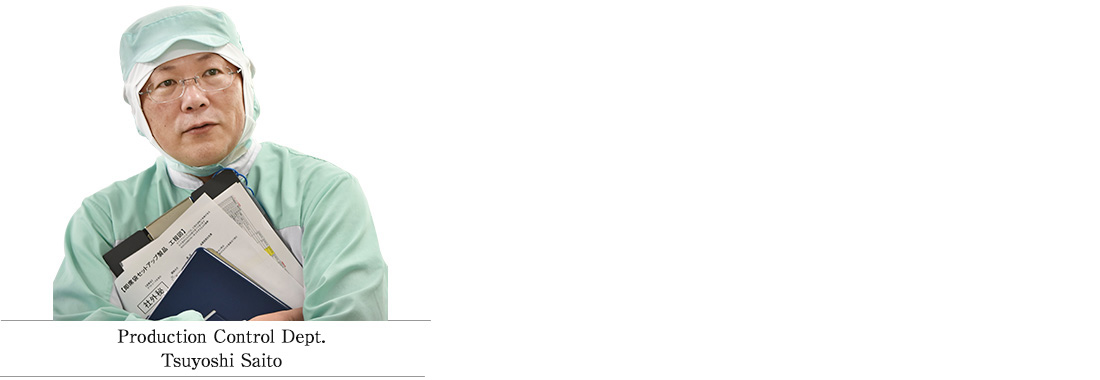

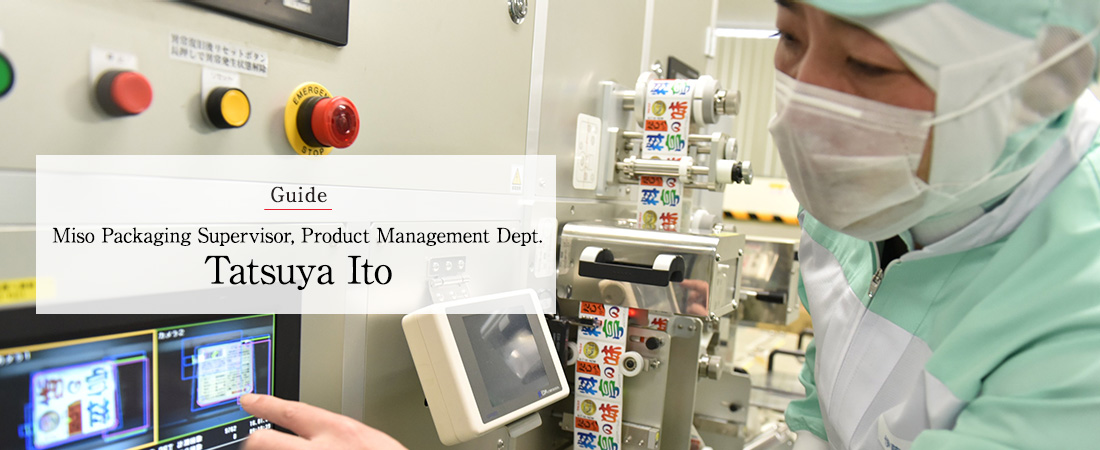
Marukome Miso's key products such as "Ryotei no Aji (with Dashi)", "Marukome Kun Awase", and "Ryotei no Aji Additive Free" are produced at the Miso Packaging Factory. The kuradashi miso is delivered from the person in charge of aging and then goes through several processes where it is mixed, seasonings are added, and the miso is heated and then cooled. Next, it is sent to the Filling process.
"We pay the utmost attention during the filling process to prevent contamination. The line is automated, but we are constantly keeping an eye out for inspection equipment that is effective for prevention." (Ito)
The miso, prepared to product specifications, passes through a specified filling filter, and then is sent to the line. If any foreign matter has contaminated the miso between the Aging Control Process and this step, it is removed here, before the miso is sent to the next process.
Image inspection machine: The label, shrink-wrap, Best Before Date, and top materials are checked. Only accepted products are shipped out.
X-ray detector: The miso is checked for foreign matter such as metal or glass.
The last step is visual inspection by humans. The inspectors check for vegetable-based ink burning, label wrinkles, and printing defects, etc. in 30-minute shifts. There have been cases when the inspector detects an incorrect label, and realized that the label-attaching machine was defective. Products are shipped only after undergoing multiple checks with advanced inspection equipment, and then checks made by actual people.
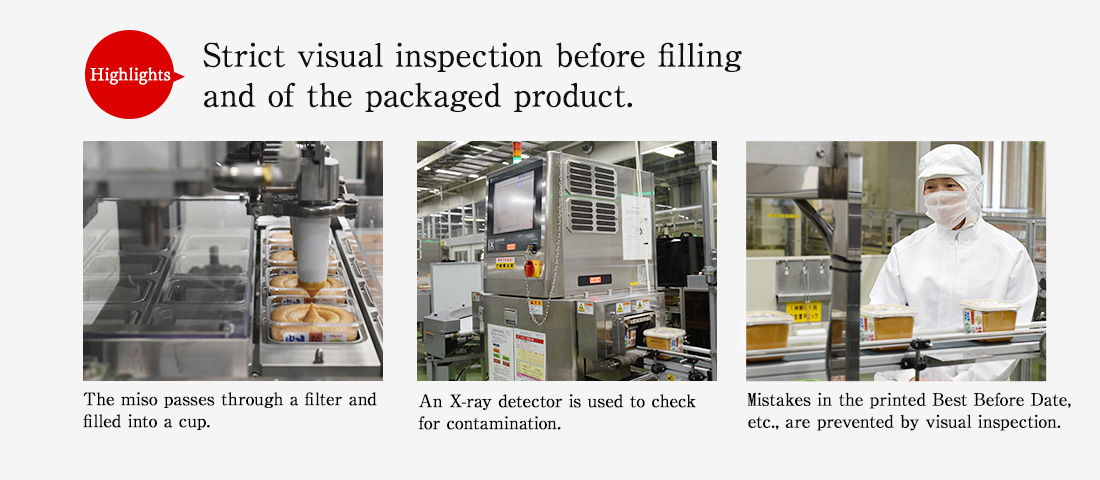
Quality relies on people. No matter how sophisticated our inspection equipment is, ultimately the quality depends on people.
For example, we must observe the rules when returning products that were backed up on the line while it was stopped or when returning touched up products to the line. If we don't, products that don't have a printed Best Before Date or those that haven't been inspected might be shipped. Since people operate the machines, we must train all the workers and make sure that they improve their skills.
Product inspections are a very important. Currently, inspectors work in 30-minute shifts. The required level of concentration is so high that I don't think I would last for five minutes.
That's why my job is to manage sanitation, maintenance, and personnel so we can control production, and to prepare safe and trustworthy products.
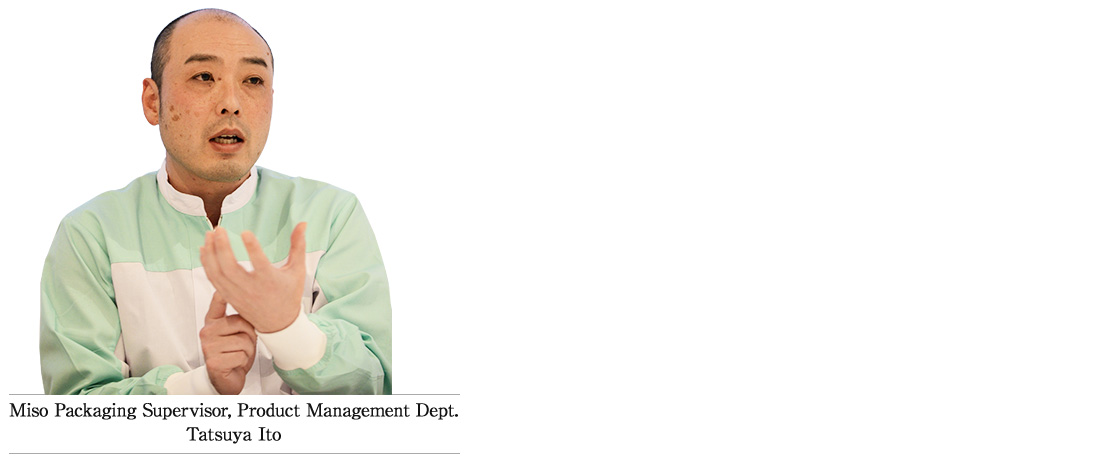

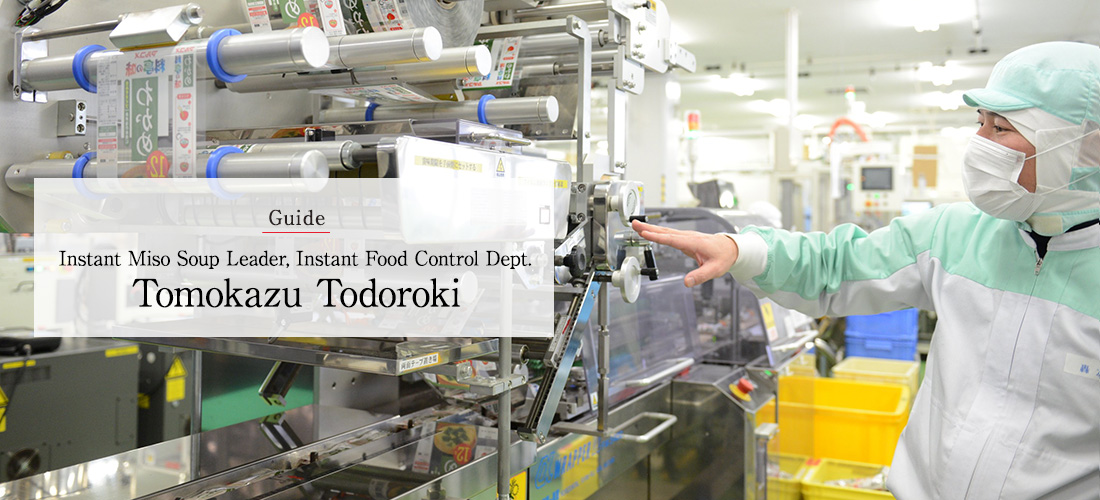
At the Instant Miso Soup Factory, we mainly produce single-serving miso packets such as "Nama Miso Soup Ryotei no Aji Wakame 12-Pack", and "Nama Miso Soup Ryotei no Aji Clam 8-Pack". Each serving is individually packaged so customers can easily enjoy a quick bowl of miso soup.
Contamination is prevented with a filling filter, advanced inspection equipment such as a metal detector and X-ray detector, and strict inspections performed by the workers.
A challenge unique to the Instant Miso Soup Factory is to prevent miso from leaking due to defective packaging. The line speed is incredible as 20 grams of product are precisely packaged into small packets, and approx. 100,000 servings (Ryotei no Aji Wakame Line) are produced in an hour. Even the slightest deviation can cause the miso to leak.
"First, we inspect the state of the packets. When starting the work process, one packet is taken from the filling machine and placed in a soaking solution to check for sealing leaks. A withstand inspection to confirm that the packet will not burst even if a 60-kilogram load is applied for 20 seconds." (Todoroki)
We also perform the following checks during the line flow.
Weight checker: The package is weighed to confirm that it contains the correct quantity.
Camera: A camera is used to check that the Best Before Date is printed correctly.
Inspector: The inspector checks the outer appearance to confirm all sides. The inspectors change shifts every 30 minutes in order to maintain their concentration.
"We use advanced equipment that uses ultrasonic waves to clean the seal when we are filling the packets, and equipment that uses images to check the Best Before Date printing. In addition, workers work with a sense of trepidation and a feeling of freshness, in order to deliver safe products to our customers." (Todoroki)
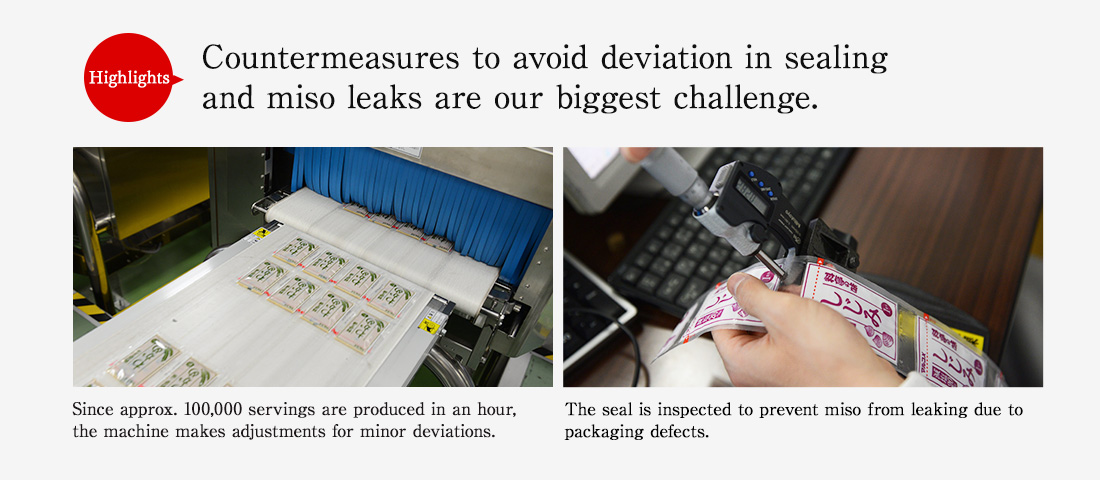
Our mission is to deliver safe products to our customers.
Every job we perform in quality control is essential, including checking the state of the packets, measures to prevent insects in the workplace, and cleaning the manufacturing line.
For example, maintenance is thoroughly carried out. Cleaning the filling filter and line after operations are completed is mandatory.
We spare no effort to increase the level of quality control.


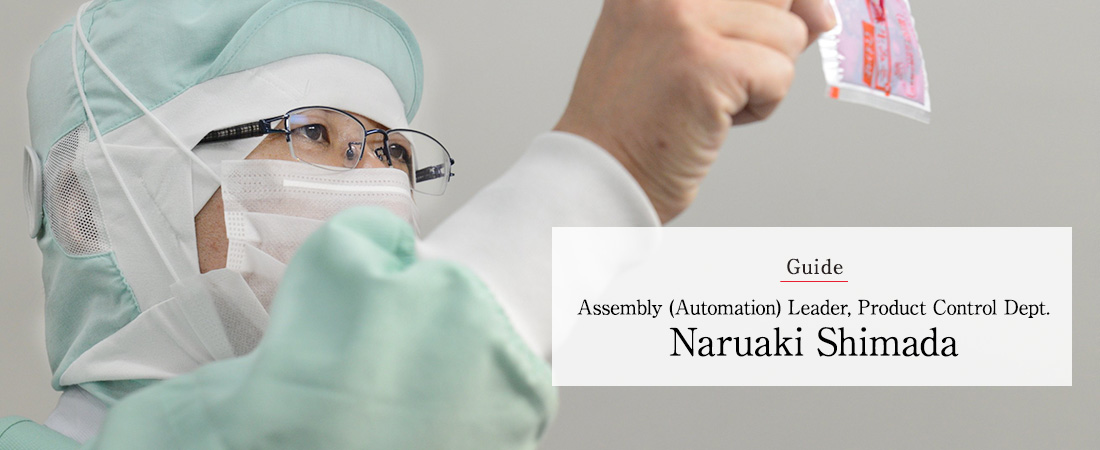
Our Takayama Plant began operation in 2012. It is a modern factory in which most work is automated. Value packs and large volume sets containing six or more packs of miso and garnish sets are produced here, including the products "Ryotei no Aji Miso Soup 12-Pack", "Value Pack Ryotei no Aji Reduced Sodium 32-Pack".
We pay close attention to contamination prevention measures just as we do at other factories. The delivered kuradashi miso passes through specific filters and put into the tank. When it is taken out of the tank, it passes through a filter again and is then sent to the filling and packaging lines. Here we check for foreign matter using metal detectors and X-ray detectors.
"At the Takayama Factory, we are especially note the quantity. Each bag contains many packets, so we always make sure that the correct number of packets are added. We use a scale to confirm that the individual packets contain the correct grams of miso, and then check the estimated weight value with an X-ray. The bagged packets are then weighed with a Weight Checker. We use the Weight Checker again after the boxing process." (Shimada)
Inspections performed by the workers are indispensable, even at the highly automated Takayama Factory. After the solution test to check the state of the seal and the withstand pressure test, a final product inspection must be performed by actual people.
"Everything is automated. If even one machine fails, the entire line stops. We pay special attention to maintenance so we can keep the machines running continuously. People do all maintenance work. We listen to the observations of the people who actually watch the machines at the factory, and actively make repairs to improve the condition of the equipment." (Shimada)
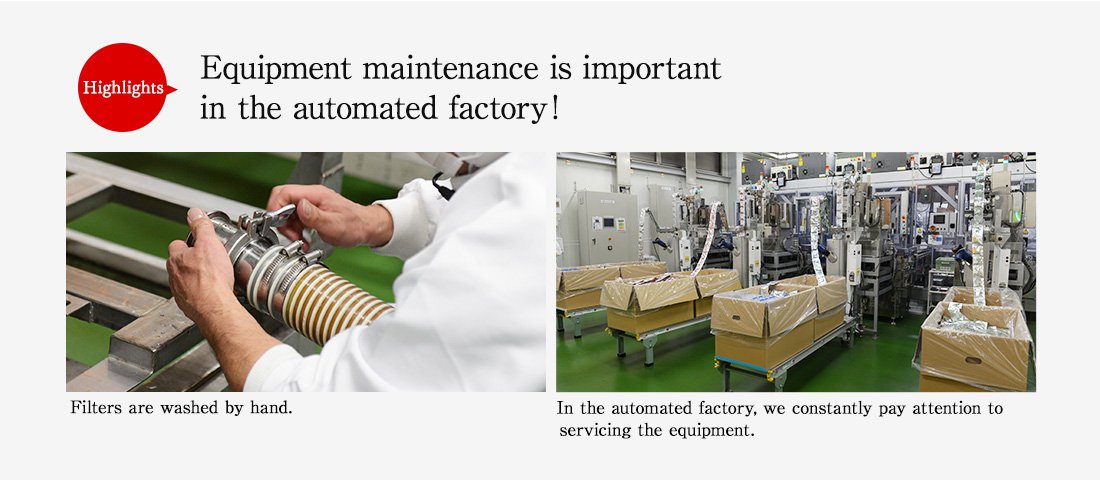
Ho-Ren-So (Report-Communicate-Seek Advice) is important in maintenance.
For example, if the workers at the site say "The current bearings don’t move smoothly. Maybe we should use a different part", we respond immediately.
I believe that a friendly atmosphere between people is especially important in an automated factory.
The Takayama Factory is equipped with cutting edge machinery and equipment to prevent contamination by foreign substances.
I work each day with the motto "We never delivery defective products from the Takayama Factory" in mind.
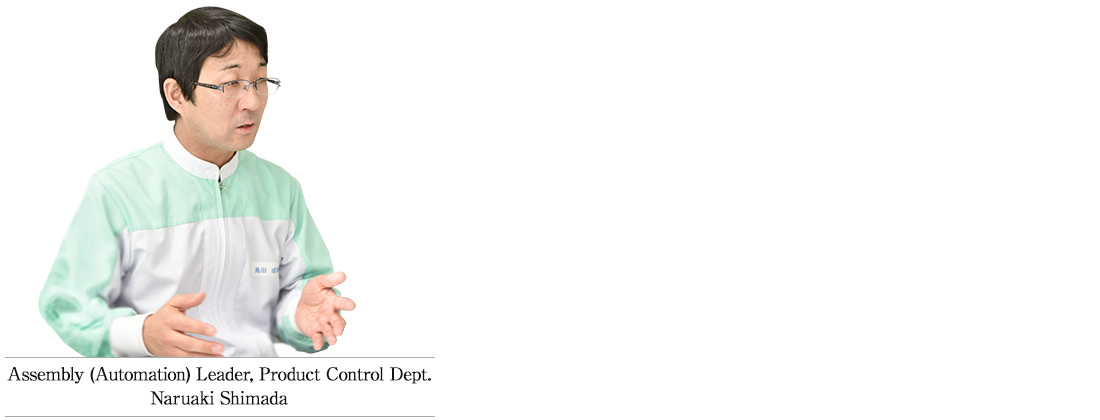

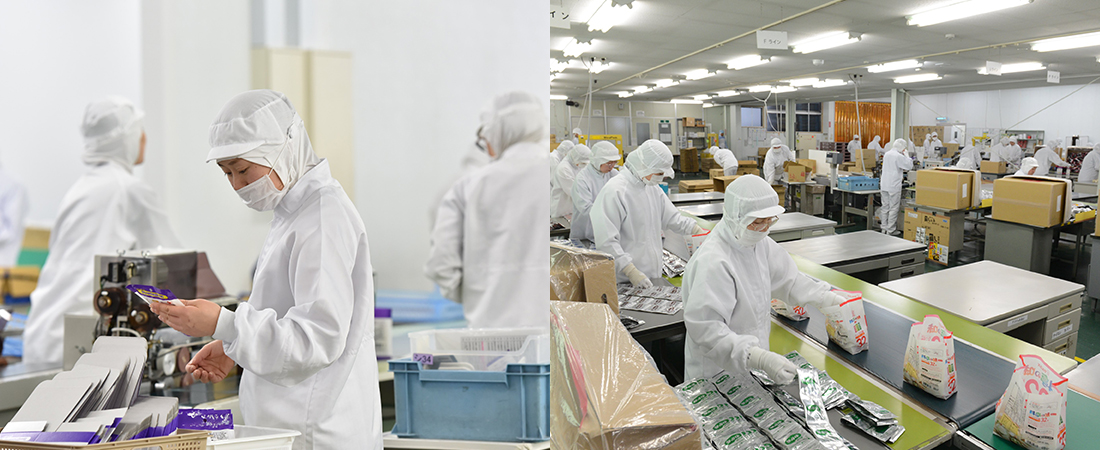
Unlike the fully automated Takayama Factory, processes are performed manually at one of the Assembly Factories. Here, we prepare small lots of Value Pack Miso Soup and other special products that include a leaflet or label attached.
"Manual work is advantageous because we can respond to specific needs. However, since people carry out the work, there are always mistakes due to preconceptions and misunderstandings. Our challenge is to eliminate those errors." (Saito)
On the assembly line, different workers add seasoned miso packages and garnish packages into bags. To prevent the bags filled with only the seasoned miso or only the garnish, an empty bag is laid on its side. When the person adds seasoned miso, he stands the bag up and returns it to the line. We apply these little modifications during each step, from packaging, to weighing, inspection, and printing of the Best Before date.
"Previously, a comment was made at a factory, "Working with products that have similar packaging next to each other is confusing, so please change the color of the packaging". We promptly change the packaging color. Expertise that has been carried down over the years is still used in today’s factory." (Saito)

I believe quality is found in people.
Quality differs depending on how a person handles and views the product. That's why I want the people involved in the manufacture of the product to love the product.
It doesn't matter how great our equipment is or how many employees work here. We cannot achieve high quality unless everyone involved likes the product.
I believe that if we take pride in our products, we can naturally provide good products to our customers.
